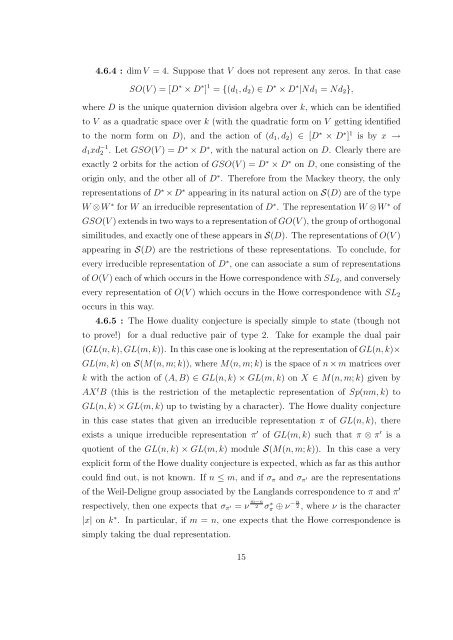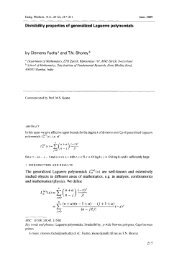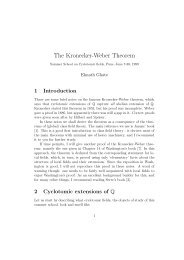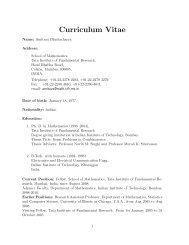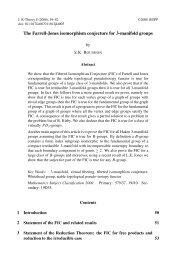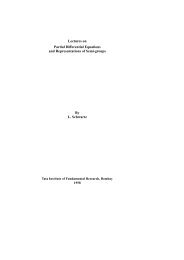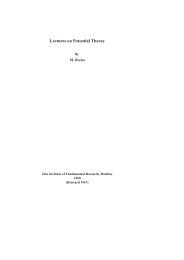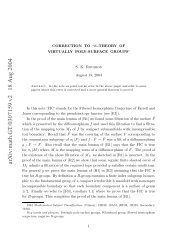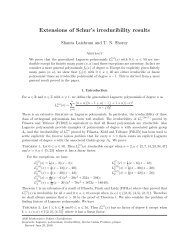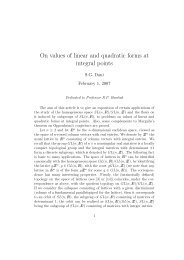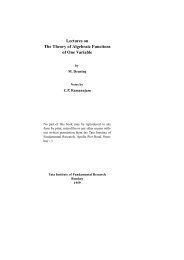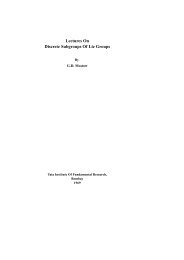Weil Representation, Howe Duality, and the Theta correspondence
Weil Representation, Howe Duality, and the Theta correspondence
Weil Representation, Howe Duality, and the Theta correspondence
Create successful ePaper yourself
Turn your PDF publications into a flip-book with our unique Google optimized e-Paper software.
4.6.4 : dim V = 4. Suppose that V does not represent any zeros. In that caseSO(V ) = [D ∗ × D ∗ ] 1 = {(d 1 , d 2 ) ∈ D ∗ × D ∗ |Nd 1 = Nd 2 },where D is <strong>the</strong> unique quaternion division algebra over k, which can be identifiedto V as a quadratic space over k (with <strong>the</strong> quadratic form on V getting identifiedto <strong>the</strong> norm form on D), <strong>and</strong> <strong>the</strong> action of (d 1 , d 2 ) ∈ [D ∗ × D ∗ ] 1is by x →d 1 xd −12 . Let GSO(V ) = D ∗ × D ∗ , with <strong>the</strong> natural action on D. Clearly <strong>the</strong>re areexactly 2 orbits for <strong>the</strong> action of GSO(V ) = D ∗ × D ∗ on D, one consisting of <strong>the</strong>origin only, <strong>and</strong> <strong>the</strong> o<strong>the</strong>r all of D ∗ . Therefore from <strong>the</strong> Mackey <strong>the</strong>ory, <strong>the</strong> onlyrepresentations of D ∗ × D ∗ appearing in its natural action on S(D) are of <strong>the</strong> typeW ⊗ W ∗ for W an irreducible representation of D ∗ . The representation W ⊗ W ∗ ofGSO(V ) extends in two ways to a representation of GO(V ), <strong>the</strong> group of orthogonalsimilitudes, <strong>and</strong> exactly one of <strong>the</strong>se appears in S(D). The representations of O(V )appearing in S(D) are <strong>the</strong> restrictions of <strong>the</strong>se representations. To conclude, forevery irreducible representation of D ∗ , one can associate a sum of representationsof O(V ) each of which occurs in <strong>the</strong> <strong>Howe</strong> <strong>correspondence</strong> with SL 2 , <strong>and</strong> converselyevery representation of O(V ) which occurs in <strong>the</strong> <strong>Howe</strong> <strong>correspondence</strong> with SL 2occurs in this way.4.6.5 : The <strong>Howe</strong> duality conjecture is specially simple to state (though notto prove!) for a dual reductive pair of type 2. Take for example <strong>the</strong> dual pair(GL(n, k), GL(m, k)). In this case one is looking at <strong>the</strong> representation of GL(n, k)×GL(m, k) on S(M(n, m; k)), where M(n, m; k) is <strong>the</strong> space of n × m matrices overk with <strong>the</strong> action of (A, B) ∈ GL(n, k) × GL(m, k) on X ∈ M(n, m; k) given byAX t B (this is <strong>the</strong> restriction of <strong>the</strong> metaplectic representation of Sp(nm, k) toGL(n, k) × GL(m, k) up to twisting by a character). The <strong>Howe</strong> duality conjecturein this case states that given an irreducible representation π of GL(n, k), <strong>the</strong>reexists a unique irreducible representation π ′ of GL(m, k) such that π ⊗ π ′ is aquotient of <strong>the</strong> GL(n, k) × GL(m, k) module S(M(n, m; k)). In this case a veryexplicit form of <strong>the</strong> <strong>Howe</strong> duality conjecture is expected, which as far as this authorcould find out, is not known. If n ≤ m, <strong>and</strong> if σ π <strong>and</strong> σ π ′are <strong>the</strong> representationsof <strong>the</strong> <strong>Weil</strong>-Deligne group associated by <strong>the</strong> Langl<strong>and</strong>s <strong>correspondence</strong> to π <strong>and</strong> π ′respectively, <strong>the</strong>n one expects that σ π ′= ν m−n2 σ ∗ π ⊕ ν − n 2 , where ν is <strong>the</strong> character|x| on k ∗ . In particular, if m = n, one expects that <strong>the</strong> <strong>Howe</strong> <strong>correspondence</strong> issimply taking <strong>the</strong> dual representation.15


